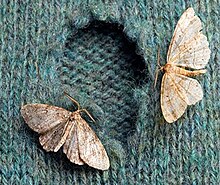Clothes moth


Clothes moth or clothing moth is the common name for several species of moth considered to be pests, whose larvae eat animal fibres (hairs), including clothing and other fabrics.
These include:
- Tineola bisselliella, the common clothes moth or webbing clothes moth
- Tinea pellionella, the case-bearing clothes moth. Obsolete names are: Phalaena (Tinea) pellionella, Phalaena zoolegella, Tinea demiurga, Tinea gerasimovi, and Tinea pelliomella
- Trichophaga tapetzella, the carpet moth or tapestry moth
- Monopis crocicapitella, pale-backed clothes moth.[1] Particularly destructive of textiles, and found to have increased dramatically in south-west England in 2018.[2]
- Niditinea fuscella, the brown-dotted clothes moth
Diet and infestation
The larvae of clothes moths eat animal fibres which are not removed by other scavengers, capable of consuming and digesting keratin materials that make up wool and fur. This leads to clothes moths attacking human-made garments and textiles that include animal fibres, damaging them and leading to their common name.[3]
Household-wide infestations can stem from a single textile, such as a garment or rug, with potential targets besides garments including upholstery, toys, or even taxidermied animals. Unprocessed fibres found around the home can contribute to infestations as well, such as pet sheddings, hair and fur buildup inside vents and air ducts, or birds' nests built inside some part of a house. Basements and attics are commonly the most heavily affected areas.[3][4] Larvae can also sometimes act as bookworms, eating through paper to reach book bindings or mold colonies for nourishment.[5][4]
Treatment and control
Various means are used to repel or kill moths. Pheromone traps are also used both to count and to destroy clothes moths, although these only attract certain species of clothes moth so it is possible to have an active clothes moth infestation without any moths being found on the pheromone traps.
Among other methods, recommendations to protect heritage collections of textiles include checking the undersides of chairs, moving and vacuum-cleaning all furniture once a month and sealing the discarded vacuum cleaner bag, checking and shaking textiles every month, and regularly checking attics and chimneys. If textiles do become infested, adults, eggs and larvae can be killed by freezing garments in sealed bags for a fortnight (14 days).
References
- ^ "Monopis crocicapitella (Pale-backed Clothes Moth) - Norfolk Micro Moths - The micro moths of Norfolk". Norfolk Moths. Retrieved 22 April 2018.
- ^ Maev Kennedy (22 April 2018). "How to avoid clothes moths: live in the east Midlands". The Observer. Retrieved 22 April 2018.
- ^ a b Michael F. Potter. "Clothes Moths", University of Kentucky College of Agriculture.
- ^ a b Parker, Thomas A (1988). Study on integrated pest management for libraries and archives, General Information Programme and UNISIST, UNESCO. PGI.88/WS/20. https://unesdoc.unesco.org/ark:/48223/pf0000082141.locale=en
- ^ "Identifying and controlling clothes moths, carpet beetles and silverfish". Department of Primary Industries and Regional Development. Retrieved April 6, 2018.
- v
- t
- e
of insects
in culture
| In the arts | |
|---|---|
| In fishing | |
| In medicine | |
| In mythology |
|
| Other aspects | |
| Economic entomology | |
| Harmful insects |
- Jan Swammerdam
- Alfred Russel Wallace
- Jean-Henri Fabre
- Hans Zinsser (Rats, Lice and History)
- Lafcadio Hearn (Insect Literature)
templates
- Insects and humans
- Insecticides
- Pesticides













